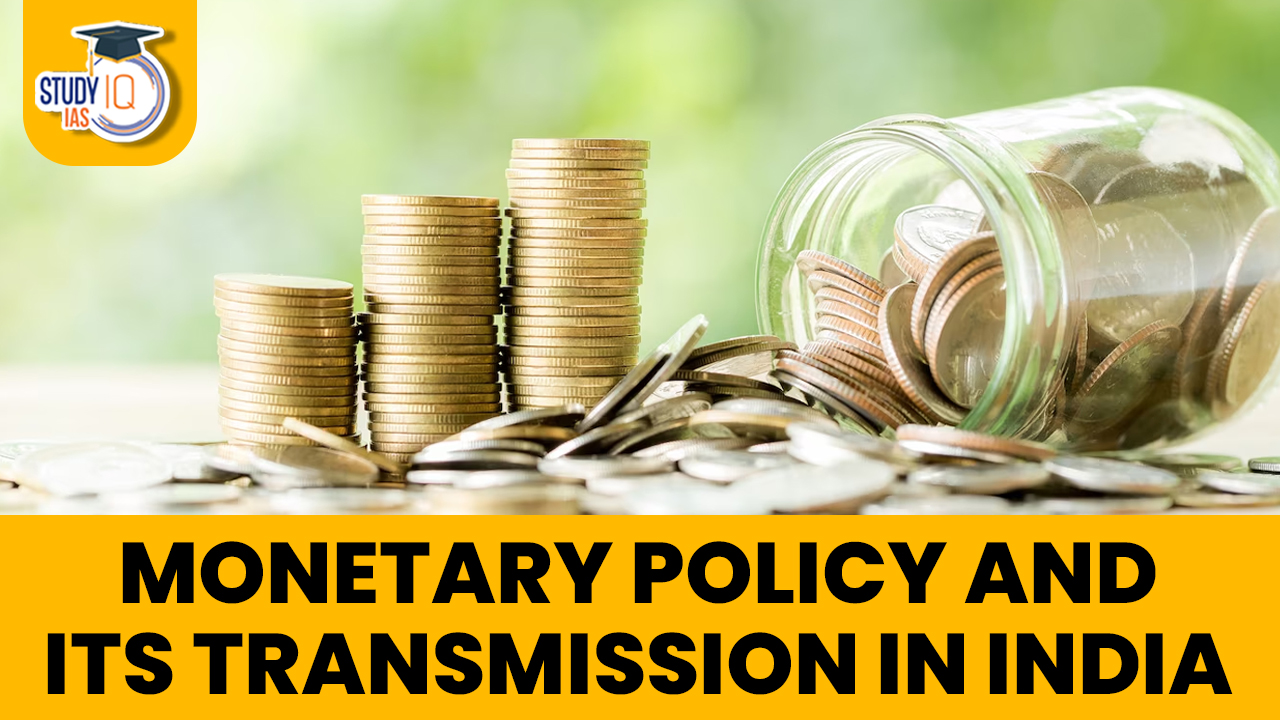Table of Contents
Context: The impact of the monetary policy and rate transmission has been asymmetrical across the debt market in the country, according to a report by the State Bank of India (SBI).
Key Highlights of the Report
- About the Report:
- The report, prepared by SBI Research, sought to examine the movement of money market and corporate bond market in response to monetary policy.
- Here, a positive relationship between the financial markets and monetary policy would indicate greater transmission.
- Asymmetric monetary policy transmission:
- Corporate bond market:
- The report said 1 per cent increase in repo rate has resulted in only 2 to 3 basis points (bps) increase in 10-year AAA corporate bond spread.
- It is 3-4 bps for the 5-year AAA corporate bond spread.
- In comparison, the shorter tenure 3-year AAA corporate bond has seen a 31-bps decline in spread.
- Money market vs G-sec market: While the transmission from a rate change is generally “instantaneous” in the money market, it is not so in the bank lending and the G-sec market given the market “idiosyncrasies”, the report says.
- Corporate bond market:
- Reasons for asymmetry in transmission: Banks facing following issues:
- High average cost of deposits and higher interest rate (due to competition from other financial institutions).
- High non-performing assets.
- Higher cost of acquiring and servicing customers.
- Non-interest operating expenses and procedural bottlenecks in recovery of dues.
- Large borrowings by the government.
Understanding Monetary Policy
- Monetary policy refers to the measures taken by the central bank (the RBI) to regulate the supply of money and credit in the economy.
- Primary objectives of the monetary policy:
- Price stability: To maintain stable prices and control inflation within a target range.
- Growth: To promote sustainable economic growth while maintaining price stability.
- Financial stability: To maintain the stability of the financial system and prevent financial crises.
- Types of monetary policy:
- Expansionary Monetary Policy: This is used to stimulate economic growth by increasing the money supply and lowering interest rates. The aim is to encourage borrowing and investment, which in turn leads to increased spending and economic activity.
- Contractionary Monetary Policy: This is used by central banks to slow down economic growth and control inflation by decreasing the money supply and raising interest rates. The aim is to reduce borrowing and investment, which in turn leads to decreased spending and economic activity.
How does the RBI get its Mandate to conduct Monetary Policy?
- The Reserve Bank of India (RBI) is charged with implementing monetary policy. The Reserve Bank of India Act of 1934 expressly mandates this responsibility.
- There have recently been many changes in the way India’s monetary policy is formed, with the introduction of the Monetary Policy Framework (MPF), Monetary Policy Committee (MPC), and Monetary Policy Process (MPP).
Monetary Policy Framework (MPF)
- While the Government of India establishes the Flexible Inflation Targeting Framework in India, the Reserve Bank of India (RBI) is in charge of the country’s Monetary Policy Framework.
- In May 2016, the RBI Act was amended to provide a legislative mandate to the central bank to operate the country’s monetary policy framework.
- The framework aims to set the policy (repo) rate based on an assessment of the current and evolving macroeconomic situation, as well as to modulate liquidity conditions in order to anchor money market rates at or near the repo rate.
- Changes in repo rates are transmitted through the money market to the entire financial system, influencing aggregate demand – a key determinant of inflation and growth.
About the Monetary Policy Committee (MPC)
- Origin: Under Section 45ZB of the amended (in 2016) RBI Act, 1934, the central government is empowered to constitute a six-member Monetary Policy Committee (MPC).
- Mandate: Further, Section 45ZB lays down that “the Monetary Policy Committee shall determine the Policy Rate required to achieve the inflation target”.
- The decision of the Monetary Policy Committee shall be binding on the Bank.
- Members: Section 45ZB says the MPC shall consist of 6 members:
- RBI Governor as its ex officio chairperson,
- Deputy Governor in charge of monetary policy,
- An officer of the Bank to be nominated by the Central Board,
- Three persons to be appointed by the central government.
- The MPC must meet at least four times per year. The MPC meeting requires a quorum of four members. Each MPC member has one vote, and in the event of a tie, the Governor has a second or casting vote.
Monetary Policy Instruments (MPI)
There are several direct and indirect instruments that are used for implementing monetary policy. They include the following:
- Liquidity Adjustment Facility (LAF): It is a tool used by the Reserve Bank of India (RBI) to regulate short-term liquidity in the banking system. It consists of two parts: repo and reverse repo.
- Repo Rate: Under the repo, banks borrow money from the RBI by selling government securities to the central bank with an agreement to buy it back at a predetermined date and price.
- Reverse Repo Rate: Under the reverse repo, the RBI borrows money from banks by lending government securities to the banks with an agreement to sell them back at a predetermined date and price.
- Marginal Standing Facility (MSF): It is a facility offered by the RBI to banks to borrow money overnight in case of emergency or unexpected shortfalls.
- The interest rate on MSF is typically higher than the repo rate and is fixed by the RBI.
- Banks can borrow up to a certain limit based on the amount of government securities they hold as collateral.
- MSF is intended to be a measure of last resort, as it is more expensive than the LAF.
- Corridor: The MSF rate and reverse repo rate determine the corridor for the daily movement in the weighted average call money rate.
- Bank Rate: It is the rate at which the Reserve Bank is ready to buy or rediscount bills of exchange or other commercial papers. The Bank Rate is published under Section 49 of the Reserve Bank of India Act, 1934. This rate has been aligned to the MSF rate and, therefore, changes automatically as and when the MSF rate changes alongside policy repo rate changes.
- Cash Reserve Ratio (CRR): The average daily balance that a bank is required to maintain with the Reserve Bank as a share of such percentage of its Net demand and time liabilities (NDTL) that the Reserve Bank may notify from time to time in the Gazette of India.
- Statutory Liquidity Ratio (SLR): The share of NDTL that a bank is required to maintain in safe and liquid assets, such as unencumbered government securities, cash and gold. Changes in SLR often influence the availability of resources in the banking system for lending to the private sector.
- Open Market Operations (OMOs): These include both, outright purchase and sale of government securities, for injection and absorption of durable liquidity, respectively.
Monetary Policy Transmission
- Monetary policy transmission is the process by which the central bank’s policy action is transmitted in order to achieve the ultimate goals of inflation and growth.
- For instance, if the RBI reduces the policy rates then the benefits of reduced lending rates must be passed on to the customers.
- Channels of Monetary Policy Transmission
- Bank lending rates: RBI rate cuts lower commercial banks’ borrowing costs, leading to reduced lending rates and increased borrowing and investment by households and businesses.
- Interest rates on deposits: Lower policy rates lead to lower deposit interest rates by banks, reducing saving incentives for households, who may then increase spending, boosting demand.
- Exchange rate: An interest reduction attracts fewer foreign investors, reducing the influx of foreign currency.
- Asset price: Asset prices, particularly stock prices, react to interest rate changes, according to empirical evidence for India, however, the amount of the influence is minor.


 Mukhyamantri Majhi Ladki Bahin Yojana, O...
Mukhyamantri Majhi Ladki Bahin Yojana, O...
 Nipah Virus (NiV): Structure, Testing Me...
Nipah Virus (NiV): Structure, Testing Me...
 Elon Musk’s America Party: A New Chapt...
Elon Musk’s America Party: A New Chapt...





















